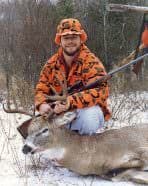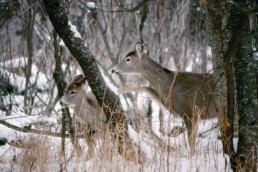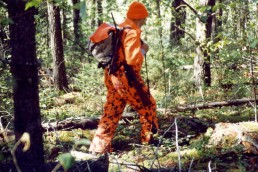Little-known Facts Every Whitetail Hunter Should Know, Part Three
SHARE THIS POST
Here’s an amazing fact for you and it’s absolutely true: To take one mature whitetail (2 1/2 years of age or older) living within any square-mile of suitable habitat, the hunter must fool all deer living in that square-mile.
By the time whitetails are 2 1/2 years old, finally living in their own separate home ranges and no longer need direction and leadership from their mothers, their eyes, ears and noses are constantly alert to sights, sounds and scents made by the 15 to 30 other deer normally living within their surrounding square-mile (or so). When any one of those other deer becomes greatly alarmed, then trotting or bounding or perhaps snorting as it flees, all whitetails within sight, hearing, or smell also become greatly alarmed, upon which they flee stealthily or noisily with great speed. Within one to four hours, all remaining deer living within that square-mile will likely realize something dangerous is near, being tipped off by behavior of other deer passing within sight or hearing—deer acting extra alert, extra cautious, assessing their backtrails, obviously concerned and ready to flee.
Alarm and fear can thus spread like wildfire in that square-mile, causing all mature whitetails and their young to temporarily abandon their square-mile before the day is done without the creature responsible for it all realizing what has happened. This is a classic whitetail response when that “creature” is a human hunter wandering through a portion of that square-mile while displaying fearsome behaviors: sneaking, changing direction and halting to peer about and listen.

Whitetails in the region where I hunt must deal with potentially very dangerous grey wolves year ‘round (black bears seldom kill deer). Rather than abandon the region, our deer have learned to live rather normal lives among them, only reacting with great alarm when it appears obvious they have been selected as a prey, being stalked or trailed. At other times, while one or more wolves are passing near—as long as those wolves are not displaying hunting behavior or are interested in them—our deer consider them “currently harmless,” in which case, it is unnecessary to flee. They merely watch them pass and then resume whatever they were doing after the wolves are no longer within sight or hearing. If a human hunter acts like a non-hunting wolf while passing a safe distance away, our experienced mature whitetails, seen or unseen (not including less experienced fawns or yearlings), are very likely to react exactly the same way. Whether carrying a firearm, bow, or not, a human walking non-stop past at a moderate pace, head pointed straight ahead (not displaying hunting behavior) on a path that does not lead too near, will also be considered “currently harmless.” By emulating wolves that only seem to be interested in reaching some distant destination, it is possible to hike to and from stand sites and even scout during hunting seasons without spooking whitetails enough to abandon the vicinity or their home ranges—imagine that.
Unfortunately for you and other whitetail hunters, all whitetails 2 1/2 years or older that live in an area where you have hunted two or more years know you incredibly well; they know you and the clothes you usually wear. They recognize your unique silhouette on the ground or up in a tree near and far away. They recognize the way you walk and remember what your footprints look and smell like. They recognize sounds and odors made by your motor vehicle (and ATV or snowmobile). They know what it means when your vehicle approaches and stops: the engine becomes silent and doors slam. If you camp in your hunting area, they realize they soon they will be hunted by you when they hear stakes being pounded into the ground and wood being sawn and chopped. They recognize the odors of foods being cooked that originate from your familiar camp location. They recognize all sounds characteristic of your camp. They remember your unique voice, coughs, sneezes and nose blowing, and sounds of your footsteps, which even disclose where you are going and when you are hunting, and dangerous and when not hunting and dangerous.
Are you enjoying this post?
You can be among the first to get the latest info on where to go, what to use and how to use it!
With noses more than 10,000 times more sensitive than a human’s, they readily recognize the combinations of more than 100 different odors unique to you alone—including odors that cannot be subdued, such as those emitted by your lungs, mouth, hair and skin. They recognize smokes and fumes originating from tobacco, foods being cooked, campfires, stoves, lanterns, an ATV and thence from your skin and clothing while hunting. They recognize odors of your gun oil and solvent and gunmetal. They recognize odors arising from the food, candy and liquids you carry. The know unique odors such as odiferous molecules that pour from your boot tops, tanned leather and rubber soles, all readily smelled four or more days or until diluted and washed away by rain or covered by snow.
The moment an experienced mature whitetail identifies you, they know it’s you. They then remember you hike early to certain spots where you sit until midday. They remember you then returned to your camp or vehicle for a while, and then returned to the same site or another familiar spot in the afternoon, remaining there until sundown. They learned you do not hunt at night like wolves, meaning they don’t have to bother to do the things they normally do to avoid you until shortly before sunrise.
All this knowledge makes it relatively easy for experienced, mature whitetails to regularly monitor previously used trails and stand sites while remaining unseen, downwind or crosswind so you can’t smell them (they don’t realize you can’t smell them). It also made it easy for them to quickly recognize any new locations and trails or sites you recently began using. Some older bucks make it a point to cautiously search for them every morning and then cleverly bed unseen where they can keep an eye on you. Those deer know you so well and can successfully avoid you day after day, living a fairly normal life throughout the hunting season. All they have to do is restrict their activities to areas they know you rarely, if ever visit, or, as some older bucks are prone to do, head to the nearest refuge or restrict their activities to darkness. All their knowledge, as well as your amazing predictability, has made your older deer extraordinarily elusive. It’s the reason most hunters are fortunate to take one to two trophy-class bucks in a lifetime. It’s the reason you may have even become convinced there is only one buck per nine to 12 does in your hunting area and/or something must be done to improve numbers of older bucks.
Now that you know what mature whitetails living in your hunting area know about you and what they do upon discovering that you have returned to hunt them, you can use your knowledge to turn the tables on them—actually, greatly improving your odds for easy, humane shots at some while they are standing still or walking slowly less than 50 yards away.
Dr. Ken Nordberg has written more than 700 magazine articles and 12 books on the habits and hunting of whitetails and black bears, including the “Whitetail Hunters Almanac” series. He also produced “Doc’s Buck and Bear Hunting School” videos. His encyclopedic website is at drnordbergondeerhunting.com.
MWO
SHARE THIS POST
Did you enjoy this post?
You can be among the first to get the latest info on where to go, what to use and how to use it!
Dr. Ken Nordberg
Based on his 55 years of field research, Dr. Ken Nordberg has written more than 800 magazine articles, 12 books on whitetails—including the famous Whitetail Hunter’s Almanac series—five books on black bear hunting and produced Buck and Bear Hunting School videos. You may peruse his encyclopedic website with whitetail hunting tips: drnordbergondeerhunting.com, his blog: drnordbergondeerhunting.wordpress.com, or social media pages.



